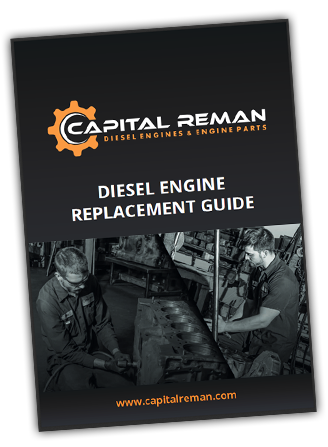Engine Failures
As a remanufacturer of heavy-duty diesel engines, Capital Reman has nearly seen it all when it comes to engine failures. We’ve talked to thousands of customers who rely on Capital Reman to replace a failed engine, and have maintained notes over time regarding the nature of failures based on various makes and model of engines. In this blog we will discuss some of the most common engine failures by make and model. We will preface the forthcoming information that not all readers may have shared the same experience based on engine make or model, but the information Capital Reman has collected over time finds this to be a true and accurate representation of what we have learned as a remanufacturer. Regardless of OEM provider, there are inherent weaknesses and design flaws in nearly every engine model that occurred long before any owner, operator, or remanufacturer touches an engine.
1. Cummins ISX: First, we must acknowledge the vast numbers of ISX dual cam and single cam engines that exist on the roads. The ISX is the Cummins workhorse and of the most popular engines Capital Reman builds and sells. They are good engines, but of all the engines Capital Reman builds, sells, and sees, it is probably the one that requires the most preventative maintenance and attention. When a customer calls to inquire about buying an ISX dual cam or single cam engine, our immediate thought is spun bearings. 8 out of 10 times that is the correct assumption. Spun bearings will typically lead to other damages that can include cylinder block damage, and obvious crankshaft and connecting rod damage. We have learned over time that the most common cause of bearing failure in the ISX is coolant entry, and the most common coolant entry point is typically from the EGR system. Good preventative maintenance routines including oil sampling, clean oil changes, and pressurized testing of cooling systems can prevent a lot of damage and unnecessary expenses.
2. CAT C15: The CAT C15 is a favorite among the diehard CAT operators and can be a very high horsepower engine. When someone calls wanting to replace a C15 we can anticipate a cracked cylinder head which allows coolant entry and contamination or blown out cylinder(s). The original design of the C15 cylinder head is somewhat underwhelming considering the HP the engine makes. The coolant that runs through the head does not lend itself to accomplishing the job very well and is a source of frustration for many owners. Further, as most readers will probably acknowledge they have either explored or have actually tuned up the HP on their C15. If not done correctly, this often leads to cylinder and head damage as the engine is not properly equipped to handle the additional HP. If done properly a lot of additional HP can be safely added to the C15 engine. A “solution” to the standard head cracking that is typical in the C15 has been addressed by the aftermarket. Some believe the aftermarket to be inferior to OE, but that is not always the case. Sure, there are lousy aftermarket companies, just like there are lousy OE companies in any industry, but the aftermarket often improves upon inherent product flaws recognized over time. That is true with the C15 cylinder head. Capital Reman sells an aftermarket C15 cylinder head that is thicker and has expanded water jackets to keep the head much cooler that the original cylinder head. This helps to prevent the common cracking, coolant leakage/consumption, and contamination. The aftermarket manufacturers have also developed advances in the piston and liner for the high HP C15 engines that make it more durable and less susceptible to cracking and failure.
3. Detroit 60 Series: The Detroit engine in our experience is one of the most robust and hearty engines on the road today. As a remanufacturer we of course see all types of failures with various makes and models, but the most common failure of the Detroit seems to be related to the gear train. Many owners or operators may disagree and immediately think the weakness of the Detroit is in the overhead with many having ceramic rollers or head/valve problems. That would not be entirely inaccurate as those are common failures of the Detroit, but it’s better to understand where the problem most often originates from, that being the bull gear. The bull gear is a vital component to the Detroit and one that needs to be examined from time to time as part of maintenance. The bearing in the bull gear can become worn over the many miles Detroit owners operate. When the bull gear fails it can, and usually does, throw the engine out of time leading to catastrophic failure by causing valve and piston contact and upper end damages. Take care of your Detroit and it will take care of you.
4. Mack Etech/Aset: Built like a Mack!! People may argue what the best engine is, but in our experience the Mack and Detroit run neck and neck in durability and longevity. If we had to score one over the other, we would probably pick the Mack as the most durable engine we build and supply. Admittedly, the use of each engine is typically very different, but that is precisely why we favor the Mack. The Mack is a hardworking, hard hauling, stop and go engine that never seems to quit. Having said that, when it does quit it is completely predictable, yet still seems to keep going. The most inherent flaw of the Mack Etech/Aset design are the lifter/camshaft combination. The Mack engine takes an “H” ring that is inserted into the block with special tooling to keep the lifters in place. Further, for many years the rollers of the lifters were made of ceramic material and may still be used in some engines. With the Mack being such a heavily utilized engine for stop and start stints, it is not uncommon for the “H” ring to distort and allow the lifters to move out of place. This often causes dragging on the camshaft and ultimately a failure to the lifter, camshaft, and many times the “H” ring bore. Many operators report hearing a tick or noise from the upper end of the engine thinking they have an overhead issue. Most often that is not the case, and a lifter/camshaft issue is mistaken for an overhead problem. The impressive thing is how long some of these have been known to make noise before an actual failure. When the lifter/camshaft does fail it is a showstopper. This failure will require removal of the camshaft and lifters which are difficult to access. The most problematic aspect of this failure is if the lifter rollers are made of ceramic material. The ceramic tends to explode in a failure and causes widespread contamination of the engine which will usually require complete teardown and in many cases block work and installation of oversized “H” rings. Capital Reman builds a lot of Mack Etech/Aset engines and due to the knowledge gained over the years will only use brand new steel lifter rollers to curb the inherent design flaw of the Mack.
Every engine regardless of the OE has design flaws that makes a future failure nearly predictable. If you operate the ISX you can eventually plan on the likelihood of having bottom end issues. If you operate a C15 or C13 you can eventually plan on the likelihood of head or bottom end issues. If you operate the Detroit it comes with its’ own peccadillos as does the Mack. Every engine needs proper maintenance and care to maintain the desired longevity and useful life. We hope any reader finds this information helpful and useful. Keep Truckin’.


 Brian is one of the original
co-founders and owners of Capital Reman. Over Capital Reman’s history, Brian has worked in nearly all aspects of the business &
industry to include sales, technical resolution, partner development, practice/policy development, and core management. Today,
Brian spends most of his time leading and developing business opportunities to further enhance and position Capital Reman as a
leader in the Heavy Duty Diesel Remanufacturing space.
Brian is one of the original
co-founders and owners of Capital Reman. Over Capital Reman’s history, Brian has worked in nearly all aspects of the business &
industry to include sales, technical resolution, partner development, practice/policy development, and core management. Today,
Brian spends most of his time leading and developing business opportunities to further enhance and position Capital Reman as a
leader in the Heavy Duty Diesel Remanufacturing space.






